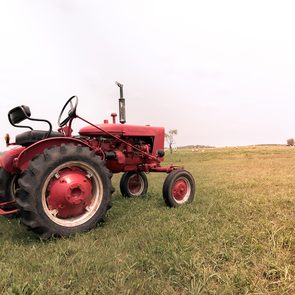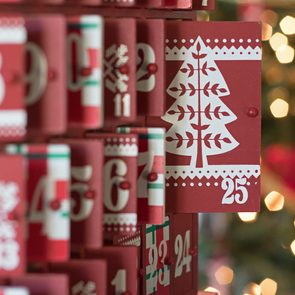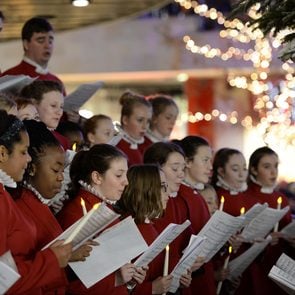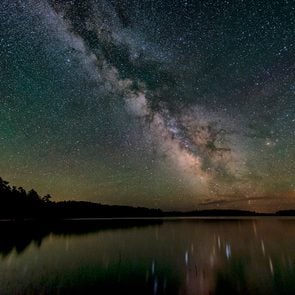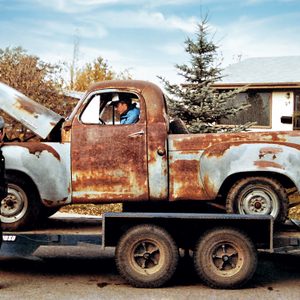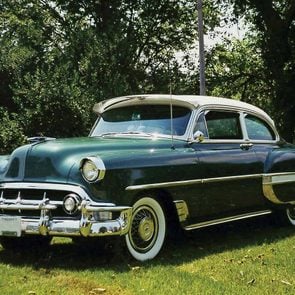Hanging stockings by the chimney with care is one of the most popular Christmas traditions, but many families display theirs without wondering why. No one can be sure exactly when and why this practice started, but some legends give us a clue to the origin of Christmas stockings.
One of the most popular origin tales starts with none other than St. Nicholas—yes, he was a real person. In the third and fourth centuries, St. Nicholas was a bishop in modern-day Turkey who made helping others his life mission, and he caught wind of a family in need.
As the story goes, a single father was raising three daughters but realized he didn’t have enough money to pay their dowries—and without dowries, they couldn’t get married. As a poor man, the father wouldn’t be able to support his daughters for long. The desperate family feared their only choice would be for the daughters to sell their bodies to make money.
St. Nicholas heard of the family’s dilemma but knew they were too proud to accept handouts. To make sure they didn’t refuse his generosity, he anonymously gave them gold at night. Some legends say he dropped the gold down the chimney, and the gifts landed in the stockings that were laid by the fire to dry, while others claim Nicholas himself hopped down the chimney. Someone—either the father or the daughters, depending on the version of the tale—caught the bishop in the act and thanked him for his help. The gifts were enough for the daughters to marry and live happily ever after.
St. Nicholas’ feast day was on December 6, and eventually, the tradition of leaving gifts in stockings was paired up with Christmas celebrations. (Here’s why we celebrate Christmas on December 25.)
That makes a neat and tidy origin story, but some scholars suggest the stocking tradition might have started even before Christianity in Scandinavian cultures. The Norse god Odin was said to come during Yule (the winter solstice), riding on an eight-legged horse. Children would leave sugar, carrots, and hay in their shoes to feed the mythical horse, and Odin would leave them gifts in return.
We’ll never know for sure what (or if) St. Nicholas really did for that family or whether the legend was inspired by pagan gods, but stockings have a strong foothold in Christmas tradition. The gift-giving origins reflect generosity and kindness… as long as you’re on St. Nick’s nice list, of course.
Next, kick off your holiday countdown with one of these unique advent calendars.
As I walk over to my new plug-in hybrid on the driveway one morning, I remember my previous car, “Old Moody,” who had been quite temperamental later in life, especially in winter. My mind backfires momentarily and I find myself trying to sort out why there’s an electrical cord connected to my car when it’s warm out and there’s no need for a block heater. I snap out of it as I pick up the cord, rightfully concluding that the electrical cord is “gassing up” my new hybrid—and also that I’m not driving anywhere holding it in my hand! I wind up the charge cord, hang it on its post and get into my car. I don’t even make it out of the driveway because I left the small door to the charging port on the side of the car open. The car sends me a message about the situation. I get out, shut the charger door, get back in, buckle up and start over again—a lot more focused this time.
Thankfully, that kind of sequence rarely happens now. When we get to the plug part, my car and I are in the present moment: my hand right hand takes the charge cord out of the socket and my left hand follows through to shut the little door.
I tend to name my cars and imagine that they have personalities. Even though they have some lifelike attributes—they move, respond to stimuli, have an ordered structure, evolve through the use of updates—it’s not that I actually think they’re people. Still, when good advice prevailed and I traded in “Old Moody”—my fully manual, fossil-fuelled old clunker that wouldn’t start in winter—for my new hi-tech hybrid that works great even on the coldest days, I have to admit, I missed “him.”
I wasn’t ready to go all the way and buy a self-driving car, but I do like the features that manufacturers are developing to help keep us safe in new vehicles. Now, all I need is a nickname for mine.
Next, find out what the government’s new electric car targets will mean for Canadians.
The original Santa Claus can be traced back to 4th-century Hagios Nikolas, the bishop of Myra in Turkey. He became famous for his generous gifts to the poor. One popular legend had him tossing bags of gold through a window for three poor women to use as dowries. After his death in 335 A.D., he was canonized as the Patron Saint of Giving. Throughout the Middle Ages, St. Nicholas gathered many followers, eventually becoming the patron saint of Greece and Russia, as well as Amsterdam. To this day, in celebration of his memory, gifts are given out on his feast day, December 6.
In 1822, Clement Moore published his famous A Visit From St. Nicholas (known more popularly these days as The Night Before Christmas), inspired by an article by the poet Washington Irving. But it was political cartoonist Thomas Nast who created the modern Santa Claus we know and love. In 1862, Nast drew Santa for the cover for Harper’s Weekly. Nast’s Santa was a kindly figure in a fur-lined suit visiting troops on the Civil War battlefield. The image stuck and Nast drew the annual Harper‘s Santa cover until 1886, adding the sleigh, reindeer and his home at the North Pole.
Who is Santa Claus Around the World
Although St. Nicholas inspired the man who is Santa Claus in North America, the character takes different names (and forms) across the globe:
- Brazil and Peru: Papa Noel
- China: Shengdan Laoren
- England: Father Christmas
- Finland: Joulupukki
- France: Pere Noel
- Japan: Santa no ojisan (Uncle Sanata)
- Germany: Christkindl
- Italy: Babbo Noel
- Ireland: Aither Nollaig
- Latin America: el Niño (the infant Jesus)
- Netherlands: Kerstman or Sinterklaas
- Norway: På Norsk
- Sweden: Jultomten
- Russia: Ded Moroz (Grandfather Frost)
Kris Kringle
In North America, “Kris Kringle” is used interchangeably with Santa, thanks in part to the classic Christmas movie, Miracle on 34th Street—but Kris Kringle represents a departure from the St. Nicholas origin story. The name itself is a mispronunciation of “Christkindl”—German for Christ Child. Introduced by Martin Luther to counteract the popularity of St. Nicholas, this figure takes on Santa’s role of gift-giver to children in Austria and Switzerland. (If “Christkindl” sounds somewhat familiar, it’s with good reason: German-style Christmas markets—now popular across Canada—are often known as “Christkindl Markets.”)
Sinterklaas
When they settled New Amsterdam (now New York), the Dutch brought their patron saint with them. Sinterklaas (also known as Sint-Nicolaas) wore a broad brimmed hat and smoked a long pipe. Along with his assistant, Black Pete, he arrives by ship to hand out gifts.
Now that you know who Santa is, check out Canada’s most magical Christmas markets.
I have lived in Alberta, relatively close to the Rocky Mountains, for most of my life. One of my favourite areas to explore is the often overlooked David Thompson Country, a true gem of the Canadian Rockies. I have enjoyed many drives, picnics, walks, waterfalls, hikes, wildlife sightings and photo opportunities here in the warmer months, and after seeing spectacular photos of Abraham Lake in the winter, I knew I needed to experience it in this season, too.
A cold snap hit Alberta at the start of January last year, as it so often does. By mid-month, Abraham Lake was frozen solid and the ice was thick enough to safely walk on. Not knowing exactly what to expect or where to go, I set my alarm for 5 a.m. in hopes of making it to the lake in time to watch the sun rise. Driving along the David Thompson Highway on the west side of the lake past Hoodoo Creek, we soon noticed a few cars parked on the shoulder of the road in the area known as the “Belly of Abraham.” My friends and I decided to join the other adventurers and soon realized that this spot was exactly what we were looking for.

Equipped with crampons, we walked over the heaves of ice along the sloped banks to the frozen lake. Even though it was still somewhat dark, I immediately spotted amazing clusters of methane bubbles trapped under the ice. With no time to waste, I chose an interesting bubble formation and set up my tripod and camera. Before long, the clouds began to take on amazing colours as the sun rose behind Mount Michener.
The day was perfect with mild temperatures and very little wind, so once full daylight was upon us, we were able to continue exploring. The frequent high winds in this region help keep the snow off the ice, making it very easy to observe bubbles even close to shore. Since Abraham Lake is actually a reservoir with a dam, there is significant vegetation under the water that releases methane. As the ice forms and thickens, the bubbles get trapped in layers, creating the most interesting stacks and formations. We were lucky enough to witness this process in action through the perfectly clear ice.

Needless to say, I was hooked and returned again a week later, a few hours before sunset. I came prepared this time with my rusty old ice skates. What a thrill to glide over the incredibly smooth ice as the wind pushed me. The return direction required much more effort but gave me time to truly appreciate all that was underneath me.
By the time the sunset colours began to form, the notorious wind had calmed down, allowing us to fully enjoy this experience. Although the sunset view over Lake Abraham is perhaps not as famous as the sunrise view, it was nothing short of breathtaking. As night descended and the other explorers and photographers headed home, we sat on the ice and watched millions of stars gradually appear. I think this was the most peaceful, magical night I have ever experienced under the stars; the only sound was the occasional cracking of the ice. I didn’t want this evening to end, but my fingers and toes were starting to tingle from the cold.

During my visits to Abraham Lake, I met people from all over the province, country and even other parts of the world who came to witness these beautiful bubbles. I am very lucky to live so close to this magical place and I can’t wait until the conditions are right to visit again.
Next, explore 50 photos showcasing the beauty of the Canadian winter.
Through the picture window on a quiet winter’s eve, December 24th, I see the familiar profile of my father. It was his silhouette through the frosted window pane, cloaked in the warmth of the table lamp light that I looked for every time I walked up the drive to the house on Christmas Eve. The trinity of candles on the windowsill, nestled in a cluster of red poinsettias, shining, tiny white lights pointing heavenly upward, always reminded me of the joyous reason for this winter gathering.
For 50 years, all nine of us—and many more as the family grew—came together this way to celebrate on Christmas Eve, all of us by some miracle managing to find our way back to the family home. It was a solid and unbroken tradition for 50 years in the Megraw family and is still unfolding.
Some of us, of course, have left this life over the years. My dad, like a lighthouse on a rock, an unwavering beacon of steadfastness and reliability, has taken flight and I think of him in the hush of heaven. My profoundly lovable younger brother John went before Dad, and in remembering them on that first Christmas Eve without them, we felt the weight of the room sighing with us at the empty places and the hearts that once filled those places with great wit, faith and celebratory good cheer that came complete with Glenfiddich whisky and beer.
In the winter of 1963, we celebrated our first Christmas in Canada, in the city of Toronto. Snow, oh glorious, deep snow like nothing we had ever seen before! My mother tells me that as a child in Ireland the snow would sometimes fall, and on the rare occasion that it did, her brother and sisters would race out the door to play in it before it fast melted under the Irish rain. A Canadian friend once said, “You know, Ireland would be a lovely place, if it had a roof over it.”
So, on Christmas Day 1963, we tobogganed in Toronto’s High Park, just above Grenadier Pond—gleeful beyond measure and thrilled by the speed of the toboggan on the snow. My parents, a young couple with five children just steps apart in age, were beginning a new life in a grand and expansive Canada. The crisp and bright cold white of a Canadian winter was energizing and so different from the misty green of Ireland.
Starting over often creates limited means and added expenses. Yet we kids wore brand new snowsuits, with my mom in her beaver coat, and my dad in his overcoat and fur cap, making the best of an exciting new beginning.
As a young girl, my mother had always dreamed of Canada, having come across many stories in The Belfast Telegraph about the land she would one day call home. Much later, when she was married and the mother of five, she spotted an ad in the Telegraph, indicating that several U.S. companies and the de Havilland Aircraft Company of Canada were coming to Belfast, seeking to hire aircraft design engineers. My dad had the requisite skills and applied to de Havilland. Three weeks later, he crossed the Atlantic by plane to begin his new job in Toronto; Mom and we kids followed soon afterwards; later, two new members were born into the family, Kevin and Megan, making us nine.
And so my parents found their path to this then foreign land, a place brimming over with potential, where they were able to raise their family and live their dreams. My mother worked in the arts, founding the South Simcoe Theatre more than 50 years ago, which showcases great musicals and plays to this day. As his engineering career drew to a close, Dad also taught at Banting Memorial High School until his retirement.
Next, find out what a 1950s Christmas was like in rural Alberta.
The Perfect Christmas Tree
One December, when I was seven and my brother, Gilbert, was 11 and a half, we headed out alone into the woods with an axe and a saw and the goal of finding the perfect Christmas tree. Two children armed with medieval cutting tools. What could go wrong?
In our house in Middle Cove, Newfoundland, the tradition was for the tree to go up the day before Christmas Eve. This infuriated us because many people on the street would have trees up a full week before Christmas. Now, of course, people put them up way earlier than that. I have neighbours in Toronto who have their Christmas tree up and decorated on November 12, and they are Jewish.
So it must have been just before the holiday when our nagging got us the go-ahead from Dad to go find the perfect tree. And this year, we were being trusted to do it entirely on our own. And while I know now he would have been happy with whatever tangly mess we brought back, we took the challenge very seriously. So, axe in Gilbert’s hand, saw in mine, we set out for all the spots we imagined we might find a magnificent fir.
We were young, but we knew the rules. Trees could only be taken from Crown land and not near any road. Also, you should look for younger trees that are in clumps of other younger trees. That way, when you take one, you’re essentially making room for the other young trees to grow. You are not, under any circumstances, to cut down a larger mature tree and just take the top off. It’s wasteful, environmentally unfriendly and just plain wrong. We knew this because Dad had said it many times when, every year at Christmas, we would come across a large, felled tree with no top.
Of course, unsupervised, it was the very first thing we did.
We started out with the best of intentions. We were on Pine River Lane, a dirt road about a kilometre from our house that cut through multiple meadows. We were looking at the small firs that ringed the fields, but none of them looked quite good enough. Eventually we started looking at the tops of the larger, more mature trees; we could see why some jerks would go that route. The tops were perfect. We sized up a monster with an attractive tip, agreed to “never tell,” and started cutting.
It took us forever. The trunk was huge, and taking turns was suddenly the worst kind of manual labour. We didn’t have a bucksaw, just a regular wood saw—a saw more suitable for cutting down young trees. The thick branches of the mighty fir prevented us from using the axe. We tried to cut the lower limbs off to make room so we could swing at the trunk, but that was also exhausting. Halfway through the trunk, we gave up. We half killed a tree for nothing. Is it any wonder they say the brains of little boys take forever to form?
It was getting dark as we headed up Middle Cove Road. Miserable. Two saps covered in same. It was Gilbert who stopped, grabbed my arm and said, “I see it!”
“You see what?” I said.
“Right there, look. It’s perfect.”
And he was right. It was a young tree, two metres tall, standing alone. It was the classic Christmas tree. In all my years, I had never seen such a perfect one.
Perfect except for one small problem. The tree was pretty close to the road. Also, it was behind a fence, so the tree was in someone’s yard. And not just any someone. It was in the yard of Timmy Green, my best friend. The Greens had one of the largest pieces of land in Middle Cove. Their grounds were heavily landscaped, with many different types of flowering bushes and trees. They were both professionals, university professor types, in fact. I suspected that they lacked a sense of humour. That said, no sense of humour would allow them to see the lighter side of what Gilbert was about to suggest.
“It’s not even really in their yard,” he said. “It’s more by the barn. I bet they wouldn’t even notice.”
They probably wouldn’t, I agreed.
That they wouldn’t notice was magical thinking at its best. This was not even a tree that was growing wild on their property. This was a tree they had planted, on a lawn they mowed regularly. This tree had come from a nursery. When spring came, there would be a ring of daffodils at its base.
“It’s really young. The trunk is small. We can have it out of there in minutes.”
I had to admit it was a pretty good-looking tree.
The chances of our finding another one like it were slim to none.
“You stand guard,” Gilbert said.
And with that, we were over the fence and on our bellies crawling toward the target.
I lay in the snow and put their house under surveillance. I was to whistle or cough if I saw anyone coming. The lights were on, but nobody came out to investigate the sounds of a saw and a panting boy.
Within a few minutes, it fell.
“Grab the end,” Gilbert said, and we heaved it over the fence. Now we were on the road. We looked back where the tree once stood. It was glaring in its absence. How we thought for a second that it wouldn’t be missed was truly absurd. It was like a car thief thinking that the homeowner wouldn’t notice the missing Subaru because there was also a Range Rover in the driveway.
This was new territory for us. We had committed a true act of vandalism. We were vandals and juvenile delinquents.
Suddenly Gilbert’s eyes widened like saucers. “Our footprints!” he said. Sure enough, all around the base of the naked stump were footprints. Boys’ footprints. We might as well have left a signed note.
Together we climbed over the fence again. We got down on all fours and wiped away our footprints with an intensity bordering on manic.
Back out on the road, it was an adventure to get home. We had probably half a kilometre of ground to cover, and every time a car approached, we would throw ourselves into the ditch, like soldiers diving into the trenches to dodge a hand grenade.
On the walk, we covered a wide range of topics, everything from “Whose idea was this anyway?” to “Do you think we will go to jail?” to “Will the Greens be mad?” and of course “the Santa factor.”
Our arrival in our yard was greeted as a triumph. The entire family agreed that we had found the perfect tree. So perfect, in fact, that Mom and Dad agreed to put it up and decorate it that very night, a full two days early.
When we were asked, “Where did you find it?” we answered simultaneously and with great confidence. “Pine River Lane,” said Gilbert. “By the pond,” I blurted.
You’d think on the walk home we would have bothered to get our stories straight.
In any event, when the tree was lit and decorated, Mom declared, as she did every year, that this was the best tree yet. For the first time, she was not lying.

“The entire house reeked of fir and guilt.”
Over the next day, we began to relax. Nobody came around and asked questions. No SWAT team surrounded the house. We started to get comfortable with the idea that we had pulled off the perfect crime. We still avoided walking past the Greens’ house in case someone was watching over the stump. I avoided calling Timmy to go sliding because the hill was on the Greens’ property. All of the children in the neighbourhood were free to toboggan on their hill. Sometimes Mrs. Green would make hot chocolate for everyone. The guilt was killing me.
The plan was to avoid the Greens altogether until perhaps the new year. So it came as a complete shock when Gilbert and I marched into the house after dinner on Christmas Eve and found John and Jane Green in our living room with our parents, drinking tea.
I had known the Greens my entire life, but never before, to my knowledge, had Timmy’s parents been in our living room. And yet here they were, on the couch, next to the perfect Christmas tree.
“Look who popped by,” said Dad.
“Hello,” I said, although no real sound came out.
And then the most astounding thing happened. Mrs. Green turned back to my parents and continued with the conversation they’d clearly been having before we came in.
It was small talk.
Gilbert and I sank to the floor looking at each other with bewilderment while the adults continued to have a pleasant conversation about nothing in particular.
Twenty minutes later, my heart rate was approaching normal when Mr. Green, on standing and getting ready to leave, suddenly turned the conversation to theft. “Have you ever had anyone cut any trees off your land, Ken?” he asked. “Someone took a tree by our barn this week, practically in broad daylight.”
My mother and father reacted to this news the way someone would react if they found out an axe murderer had moved in next door.
“In your garden?” Mom said, aghast. “Can you believe it.”
“Brazen,” Dad said.
“Who in God’s name would do that?” Mom asked.
I thought I was going to die. “They have to know,” I thought. This was an elaborate torture. The tree was literally under their noses. The entire house reeked of fir and guilt. Of course they knew it was us.
It dawned on me that I had never, ever been in this much trouble before. I was about to speak when my eyes caught those of my brother. As he reached up to scratch his neck, he ever so subtly made the universal symbol for “do not say a word,” his index finger crossing his windpipe like a knife.
And suddenly the Greens were reaching for their coats.
“Well, that was nice. Thanks for the tea,” said one of them.
“Come again,” said Dad. “Don’t be strangers.”
“Merry Christmas,” said the Greens directly to my brother and me. And as if they meant it, “Hope Santa finds you.”
“You too,” I croaked. Was my voice choosing now to change?
“Lovely tree,” said Mr. Green.
“Isn’t it,” said his wife.
And then they were gone. And Mom and Dad were taking the empty cups to the kitchen.
I was hyperventilating on the floor, but Gilbert threw himself on the sofa with total confidence. Cool. Collected.
“Told ya,” he said. “They didn’t suspect a thing.”
To this day I have no idea whether they knew it was us who cut down the bloody thing. If they did, why did they remain silent? Maybe they thought it better to just let the guilt punish us. Or maybe, because of their decency, they never considered in a million years that the tree from their land was the one standing in our house with an angel on top.
I do know that many times over the years I’ve considered confessing to them. They still live down the street in the same house.
In our defence, all I can say is that we never took a tree on anyone else’s property ever again. My parents were legitimately horrified when the truth came out in our house many decades later. They were shocked to learn they had raised history’s greatest monsters and didn’t know it. And they couldn’t believe we had both sat there in the room with the Greens while the tree was discussed and we didn’t crack.
“Terrible,” Mom said. “Although it was a nice tree.”
If you are reading this, John and Jane, my abject apologies. I’ll drop off a sapling in the spring.
Excerpted from Talking to Canadians, by Rick Mercer. Copyright © 2021, Rick Mercer. Published by Doubleday Canada, an imprint of Penguin Random House Canada Limited. Reproduced by arrangement with the Publisher. All rights reserved.
Next, check more funny Christmas stories shared by our readers!
You’ve probably given some thought to the type of salt you use at home—particularly, whether you choose sea salt or good old-fashioned table salt. Less processed than traditional table salt, both sea salt and Himalayan salt retain more of their original mineral content, such as magnesium and potassium. But do the trace minerals and elements mean sea salt is healthier?
It turns out—maybe not.
Sea Salt vs. Table Salt
Lots of people assume sea salt is better because of its minerals—but sea salt and table salt have the same basic nutritional value, according to the Mayo Clinic. Both sea salt and table salt also have a similar amount of sodium by weight.
According to a study published in the Environmental Science and Technology Journal, sea salt has more than trace minerals, too. In many cases, there’s also plastic leeched onto sea salt. Yes, plastic! The problem is, thanks to the plastic bags and other debris in waterways, most sea salt brands contain plastic microparticles.
What About the Iodine in Table Salt?
Produced in salt mines, traditional table salt is more processed than sea salt. This means it’s mostly devoid of natural minerals, which might be where a lot of table salt’s bad press comes from. It’s worth noting, however, that since the 1920s, producers have added iodine to processed salt. It’s an important mineral for keeping your thyroid happy.
Here’s the Bottom Line
When it comes to salt intake, your best bet is moderation. No one type of salt is better for you, so you can’t go wrong by lowering your intake.
Now that you know the lowdown of sea salt vs. table salt, find out what can happen when you eat too much salt.
Although your urge to decorate might tempt you to buy a Christmas tree early in the festive season, the cheapest time to buy one is actually much closer to December 25th than you might think. In fact, according to research conducted by the folks at financial services company Square, the price of a Christmas tree during the holiday season tends to drop to its lowest—$34 on average across Canada—four days before Christmas. Compare that to the most expensive time to buy a Christmas tree—the first Tuesday of December—when trees go for $83 a pop on average, and you can see there are considerable savings to be had by playing the waiting game.
There are more factors to consider when buying a Christmas tree than the cost, of course. To help guide your decision on the best time to buy a Christmas tree, Square research revealed the following:
- If you can’t stand crowds, avoid lots the first weekend of December, as this is the most popular time to buy a Christmas tree. (It’s no coincidence this weekend is also one of the most expensive times to buy!)
- The average price of a Christmas tree across Canada is $53.
- The five top-selling Christmas tree varieties across Canada tend to be the Balsam Fir (average cost $53), Scots Pine ($36), Fraser Fir ($59), Nordmann Fir ($81) and Douglas Fir ($40).
Next, find inspiration for your holiday shopping with our great Canadian gift guide.
I’ve grown up around vintage cars. My grandfather, Gordon Boyd, brought home our 1930 Cadillac V8 club sedan in May 1980, 18 years before I was born. At the time of purchase, all he took with him was the partial wood frame and the rear tire; everything else was taken apart and later brought home in boxes and baskets. The amount of work that’s gone into the car is unimaginable—it wasn’t road worthy until I was about 12 years old. I loved the car from my first ride in it and it has been a passion ever since.
My grandfather was a member of many different car clubs, but it was Antique Classic Car Club of Canada events that we frequented most. Even though I was just a kid, club members expected me to be there, and they’d hound my grandfather if I wasn’t! I was made an honourary member at 14, and an official member at 18. I always loved attending events with my grandfather, but it was nice to be acknowledged as a car lover in my own right.
My grandfather passed away on May 21, 2017, after a five-year battle with cancer, making it all the more important to remain involved with the second family I had found within the car community. I had my first tour without him on June 3, 2017, and everything about that day brought me to tears. The best and worst parts of that day happened when we returned to the tour’s starting point, which was situated at a club member’s house‚ the very place where a family friend had taught me how to drive his 1930 Cadillac V8 Victoria two-door coach after my grandfather’s passing. Not having my grandfather there to see me complete the tour was heartbreaking, but the memories of all the time spent together doing something we loved had the opposite effect.
Keeping my passion alive will be easy, with the help of the community, as well as the comfort of the Cadillac club sedan, which my grandfather bequeathed to me. It will be with me for the long haul, as will my memories of my grandfather.
Don’t miss this impressive restoration of a 1931 Model A Ford.
When it’s cold outside, a car fire is probably the last thing on your mind. But that’s just the time when fires at the gas pump are more common.
The motion you make when you slide across your car to get out can create static electricity. And when you’re about to fill up your vehicle, that can be dangerous. (Here are 13 things you’re doing in your car—but shouldn’t.)
“You get that static discharge from your body to that metallic nozzle, and when that occurs, there’s potential for a spark to happen,” says Scott Boorse, director of technical programs and industry affairs for the Petroleum Equipment Institute (PEI). “That spark is enough to ignite any of the vapours that are around the tip of the nozzle.”
PEI has received reports of about 200 incidents at the gas pump caused by static electricity since the mid-1990s. But Boorse says there are probably many more cases that aren’t reported. While quick sparks are common, full-out fires are less so.
So how can you avoid a fire at the pump? Fortunately, there’s an easy solution. When you get out of your vehicle, make sure you touch a metal part of your vehicle before you reach for the nozzle. That will dispel any electric charge you may have created.
Another easy trick? Touch one of the thin metal strips that runs vertically on the left and right side of most gas dispensers before you fuel up.
Now that you’ve mastered this simple way to avoid car fires, here’s how to find the cheapest gas station near you.



